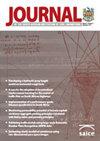Three-dimensional contact stresses of a slick solid rubber tyre on a rigid surface
IF 0.4
4区 工程技术
Q4 ENGINEERING, CIVIL
Journal of the South African Institution of Civil Engineering
Pub Date : 2021-11-11
DOI:10.17159/2309-8775/2021/v63n3a1
引用次数: 1
Abstract
The main aim of this paper is to quantify the three-dimensional contact stresses imposed by a single slow-moving (or rolling) slick solid rubber tyre on a relatively rough contact surface, such as stiff asphalt concrete or airport concrete surfacing layers. The results indicated the tyre-contact patch of a slick solid rubber tyre to be of rectangular shape for a vertical tyre loading range between 20 kN and 100 kN. The rectangular tyre contact shape was confirmed with static paper prints, as well as an electronically measured contact patch with the stress-in-motion pad device. The study included load calibration using a mass load scale, and a stress-in-motion device. These were used with an existing full-scale accelerated pavement test device, referred to as the heavy vehicle simulator. In addition, simplistic multi-layer linear elastic modelling was used to quantify differences between stress and strain responses of two types of two relatively 'stiff' based pavements, such as an asphalt concrete base and Portland cement concrete base, on similar subbase and subgrade layers. Notable differences were obtained, which could potentially influence further detailed studies on the performance of full-scale slick solid rubber tyres on typical multi-layered pavements.光滑实心橡胶轮胎在刚性表面上的三维接触应力
本文的主要目的是量化单个缓慢移动(或滚动)光滑的固体橡胶轮胎在相对粗糙的接触表面上施加的三维接触应力,如坚硬的沥青混凝土或机场混凝土面层。结果表明,在20 kN至100 kN的垂直轮胎载荷范围内,光滑实心橡胶轮胎的轮胎接触片为矩形。矩形轮胎接触片的形状已通过静态纸印以及带有运动垫应力装置的电子测量接触片进行了确认。该研究包括使用质量负荷秤和运动应力装置进行负荷校准。这些与现有的全尺寸加速路面试验装置(称为重型车辆模拟器)一起使用。此外,使用简单的多层线弹性模型来量化两种类型的两种相对“坚硬”的路面(如沥青混凝土基层和硅酸盐水泥混凝土基层)在类似底基层和路基层上的应力和应变响应之间的差异。获得了显著的差异,这可能会影响对典型多层路面上全尺寸光滑固体橡胶轮胎性能的进一步详细研究。
本文章由计算机程序翻译,如有差异,请以英文原文为准。
求助全文
约1分钟内获得全文
求助全文
来源期刊
CiteScore
0.70
自引率
25.00%
发文量
19
审稿时长
>12 weeks
期刊介绍:
The Journal of the South African Institution of Civil Engineering publishes peer reviewed papers on all aspects of Civil Engineering relevant to Africa. It is an open access, ISI accredited journal, providing authoritative information not only on current developments, but also – through its back issues – giving access to data on established practices and the construction of existing infrastructure. It is published quarterly and is controlled by a Journal Editorial Panel.
The forerunner of the South African Institution of Civil Engineering was established in 1903 as a learned society aiming to develop technology and to share knowledge for the development of the day. The minutes of the proceedings of the then Cape Society of Civil Engineers mainly contained technical papers presented at the Society''s meetings. Since then, and throughout its long history, during which time it has undergone several name changes, the organisation has continued to publish technical papers in its monthly publication (magazine), until 1993 when it created a separate journal for the publication of technical papers.

 求助内容:
求助内容: 应助结果提醒方式:
应助结果提醒方式:


